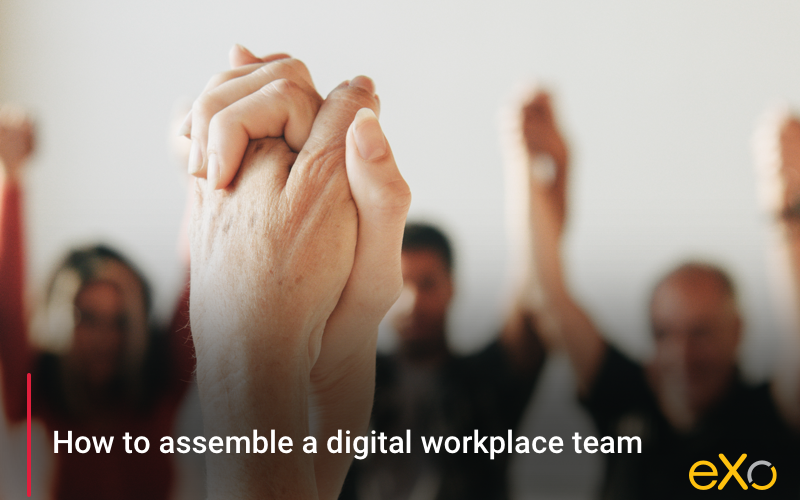In truth, a digital workplace project is a multidisciplinary one. A host of teams should be included in various phases of the project from researching and planning all the way to change management, launch, post-launch and so on.
This leads us to three important questions:
(1) Which teams or departments should be included in a digital workplace project team?
(2) What are the common and most important roles?
(3) What are the best practices to approach such a project?
In this blog post we will try to answer these questions and share our years of experience managing digital workplace projects and dealing with a diverse client portfolio.
As mentioned earlier, a digital workplace project is designed for everyone in a given organization. This means that multiple teams and departments should have their say in selecting and managing the digital workplace.
When we approach a technology related project, the focus shifts primarily to IT, and rightly so. At the end of the day, their deep understanding in technology, knowledge of the collaborative market and the available solutions give them an edge over other teams especially in the initial phases. Here, IT has the critical responsibility to either choose the right solution among many or build one from scratch. This is why during product demos for example, IT team members are always present to ask a variety of functional and especially technical questions about hosting, software development, among other questions.
Having said this, a digital workplace project team shouldn’t only include IT, HR and internal communications. Different industries have different challenges, which induce a whole new approach and teams to effectively put in place and run a digital workplace. For example, within highly regulated industries such as healthcare and finance, organizations should take into consideration the critical nature of the information stored and exchanged within and between departments by including stakeholders responsible for managing large volumes of data and communicating policies and procedures.
Additionally, we cannot speak about a project of this magnitude without referring to decision makers. Generally speaking, people responsible for making such decisions should always be in direct contact with the departments we have listed above. Decision makers often include the C-suite (CIOs, COOs all the way to CEOs depending on the organization). The reasoning behind this is rather straightforward. Typically, the C-suite has better visibility on available budget and is directly involved in producing the digital workplace governance model. The latter should be in line with the whole organizational vision and refers to the collection of processes, roles, responsibilities and rules that can deliver and shape the digital workplace.
Before discussing the roles and responsibilities of project team members, we should first identify the various phases of a digital workplace project. Generally, a typical digital workplace project can be divided into two main parts. First is research and planning. Here members are responsible to assess their current IT environments, identify any user painpints, look for potential solutions and, last but not least, implement the chosen one. The second phase is more about managing and maintaining the digital workplace. Here, team members are expected to ensure high levels of adoption and engagement through various types of content, managing permissions and access control and eventually measure and assess the digital workplace for future improvements.
Now that you have an overall idea about the various phases of a digital workplace project, let’s dive deeper into each role.
As is the case with any new initiative, digital workplace projects require a project manager. The latter will be involved during every phase of the project by coordinating different stakeholders and making sure the project is conducted within the predefined budget and time.
The digital workplace committee usually consists of executives who determine the whole vision of the project and provide the required funds for the project team. More often than not, the digital workplace committee has the final say in selecting the solution and laying the foundation for its usage. They are always in constant contact with different parties to stay up to date with the latest developments and act accordingly by developing and aligning strategies and visions.
The digital workplace administrator is mainly responsible for handling matters regarding the overall and day-to-day functioning of the digital workplace. Their main priorities are to ensure that users are well equipped to use the solutions to its full capacity and especially, that they are well aware of the various policies, procedures and guidelines.
In most digital workplace teams, administrators are also responsible for managing permissions (be it accessing specific content or areas/spaces) in order to ensure that content is secure and can only be displayed to the right people. Last but not least, this role also involves determining and tracking specific KPIs (usage, engagement and efficiency metrics, satisfaction scores, among others).
Community managers and content creators
It goes without saying that content is the backbone of any successful digital workplace. This is why it is extremely important to assign content creators whose sole objective is to create and convey compelling content in order to engage communities and keep them informed about a variety of news, activities, events and policies.
The first step towards assembling a digital workplace project team is to establish the project’s overall scope. By answering the “what”, “why” and especially the “how” of the project, team leaders would have a holistic view of what is needed to accomplish these goals and would be able to determine the skills and capabilities to look for in potential team members.
Once the project’s scope is identified, it is important to break down the project into a set of tasks and subtasks. This way, team leaders would be able to associate certain activities with the individuals most qualified to manage and handle them based on their skills set and of course their level of experience.
Each of the roles mentioned above require individuals who have the capacity to perform them. For example, project managers should be able to effectively coordinate various stakeholders and lead by example, administrators require the technical expertise to handle technicalities and effectively manage the platform and content creators should obviously be effective in creating and conveying content.
Another important quality to look for is organization. Organized individuals make for excellent team members and for a good reason. Their ability to organize their tasks by order of importance coupled with their efficient use of resources would significantly help the entire team respect predefined deadlines and achieve the project’s overall objectives.
Additionally, when selecting team members, experienced team leaders often look for proactive individuals. The latter are synonymous with leadership, control, preparation and the capability to anticipate changing circumstances.
When it comes to digital workplace projects or any other project for that matter, the more diverse the team the more it is able to innovate, come up with new ideas and solve problems efficiently. With diverse teams, there are endless possibilities for team members to learn from each other’s experiences and expertise which can only be beneficial for the entire team. Additionally, having individuals from diverse backgrounds would eventually help in widening perspectives and examining problems from a variety of lenses, which can only lead to better informed decisions.
A common misconception about selecting and creating project teams is that they solely revolve around the individual qualities of team members. Sure, as we have mentioned there are certain qualities and skills that should be considered.




